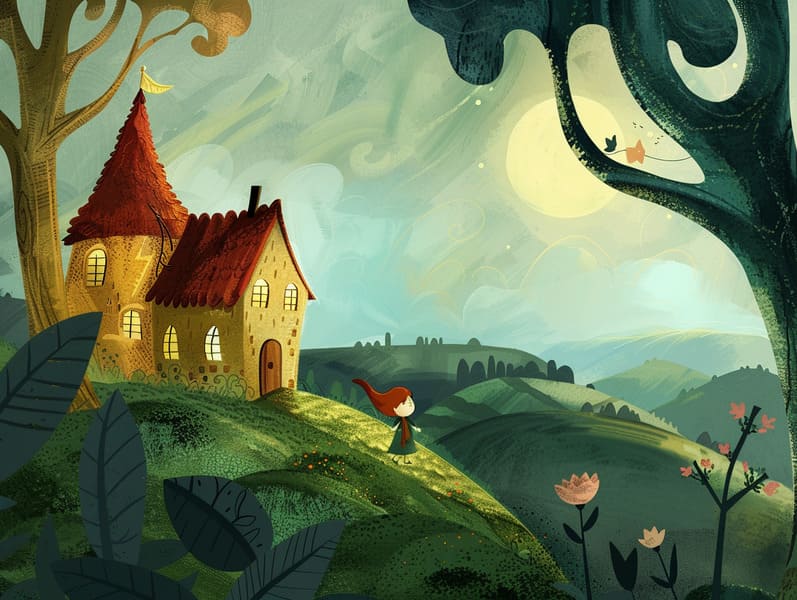
Fairy tales have historical significance. These stories have been transmitted from one generation to the next centuries before they were ever published. They sprang from a variety of traditions, including Middle Eastern traditions. They were initially narrated among elders, often carrying themes and messages relevant to the societal norms and beliefs of the time.
The famous Grimm duo, Jacob and Wilhelm Grimm, were among the first to gather and publish many of these beloved tales. Their anthology, "Grimm's Folk Tales," included narratives like "The Little Glass Slipper," "Hansel and Gretel," and "Snow-White and Rose-Red," which have since become hallmarks in the world of traditional fairy tales. Similarly, Andersen's charming tales, such as "The Sea Maid," and "The Story of the Ugly Duckling," have stolen hearts worldwide, establishing their place in the pantheon of timeless fairy tales.
Despite their age, these stories remain as important as ever, especially as bedtime stories for kids. These magical stories are now available in many formats, including beautifully illustrated books, captivating animations, and online fairy tales.
Their enduring popularity can be credited to several charming aspects:
Life Lessons: Traditional fairy tales often offer important moral lessons. Fairy tales like "The Wolf and the Liar" teach the value of truth, while "The Tortoise and the Hare" emphasize the values of perseverance and meekness. These tales offer kids clear distinctions between good and bad, building their moral compass in a tender yet significant way.
Empathy and Awareness: Old fairy tales frequently illustrate characters facing obstacles and hardships, urging young readers to empathize with their struggles and rally behind their triumphs. For instance, "Beauty and the Beast" demonstrates the significance of looking past the exterior to understand the true character of a character, encouraging understanding and insight.
Cultural Insights: Many ancient fairy tales are saturated in the cultural contexts from which they came. Reading these tales can provide illuminating insights into different societies, promoting a sense of global appreciation and perception.
Imagination and Innovation: The extraordinary elements in old fairy tales—fairy godmothers—inspire children’s creative thoughts. These stories bring readers to mythical realms, triggering inventive dreams and a sense of amazement that endures a lifetime.
Traditional fairy tales are not only charming but also didactic. They function awesome site as captivating tools in strengthening various thinking and feeling skills in young ones. When ancient fairy tales are recited, they cultivate language skills by teaching new terms and detailed sentence structures. This practice also enhances auditory skills and attention, as kids pay close attention, anticipating to see what happens next.
Furthermore, discussing the themes and characters of traditional fairy tales can develop reasoning skills and problem-solving abilities. Little ones learn to detect patterns, anticipate outcomes, and grasp cause and effect. These discussions also further little ones articulate their thoughts and feelings, adding to their emotional intelligence.
In today’s online age, the proliferation of digital storybooks has made these stories more attainable than ever. Online resources and digital apps share vast collections of famous fairy tales that can be explored or played anytime, anywhere. Fairy tales read aloud are particularly in demand, featuring an fun way for young ones to take part in these alluring stories. Voice books and read-out-loud stories guide characters and settings to life, often augmented by whimsical audio effects and soundtracks that improve the tale-telling adventure.
The lasting appeal of ancient fairy tales lies in their ability to adjust to present eras while keeping their key morals. Contemporary updates of these narratives often bring in more representative protagonists and modern settings, making them accessible to today’s audience. However, the central morals of boldness, generosity, and honesty remain unchanged, continuing to connect with children of all ages.
Fairy tales also offer a sense of calm and closeness. They deliver a neat narrative with a plain beginning, middle, and end, often concluding with the ending of conflicts and the triumph of honesty over deceit. This reliability can be placating for children, distributing a sense of solidity in an unstable world.
Traditional fairy tales continue to spellbind and teach new generations, maintaining their majesty and significance in modern society. As kids' bedtime tales, they supply a perfect blend of charm and understanding, boosting moral values, empathy, and creativity. The accessibility of online fairy tales and the widespread nature of fairy tales narrated validate that these traditional fairy tales remain within reach to new generations.
By continuing and communicating these fairy tales, we continue to acknowledge the rich tapestry of legends and cultural heritage. Whether you are browsing a vividly illustrated book, delving into a online library, or hearing an voice book, the delight of ancient fairy tales is always within reach. These narratives reveal of the unending spell of tales and its ability to bind us across epochs and places.
No matter if you are seeing a beautifully illustrated book, viewing a digital library, or listening via an read-aloud book, the allure of Grimm's fairy tales is always within reach.
These stories illustrate of the continued force of tales and its ability to hold us together across generations and cultures, weaving a spell that delights and instructs alike.